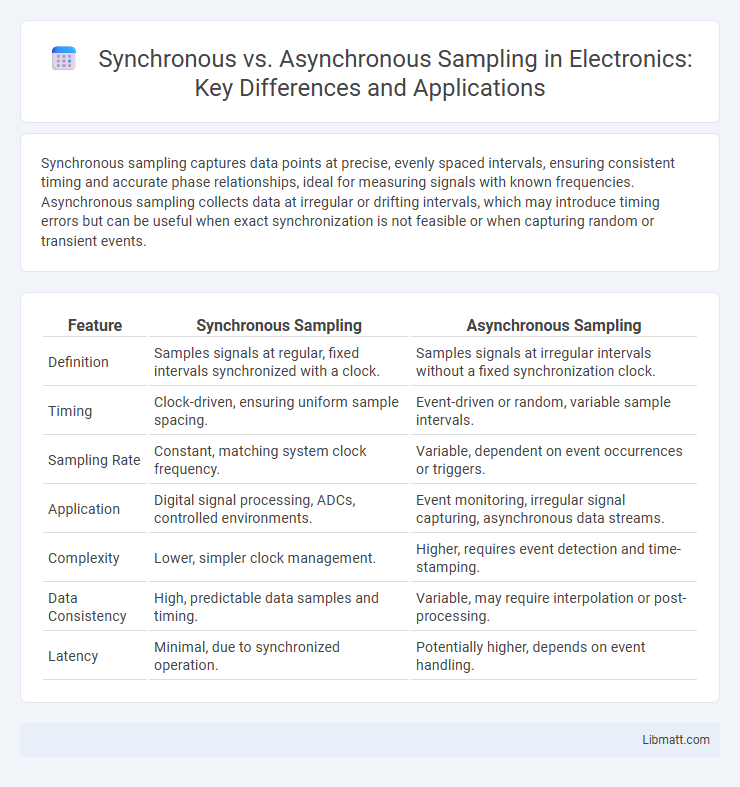Synchronous sampling captures data points at precise, evenly spaced intervals, ensuring consistent timing and accurate phase relationships, ideal for measuring signals with known frequencies. Asynchronous sampling collects data at irregular or drifting intervals, which may introduce timing errors but can be useful when exact synchronization is not feasible or when capturing random or transient events.
Table of Comparison
| Feature | Synchronous Sampling | Asynchronous Sampling |
|---|---|---|
| Definition | Samples signals at regular, fixed intervals synchronized with a clock. | Samples signals at irregular intervals without a fixed synchronization clock. |
| Timing | Clock-driven, ensuring uniform sample spacing. | Event-driven or random, variable sample intervals. |
| Sampling Rate | Constant, matching system clock frequency. | Variable, dependent on event occurrences or triggers. |
| Application | Digital signal processing, ADCs, controlled environments. | Event monitoring, irregular signal capturing, asynchronous data streams. |
| Complexity | Lower, simpler clock management. | Higher, requires event detection and time-stamping. |
| Data Consistency | High, predictable data samples and timing. | Variable, may require interpolation or post-processing. |
| Latency | Minimal, due to synchronized operation. | Potentially higher, depends on event handling. |
Introduction to Data Sampling Methods
Data sampling methods are essential for capturing and analyzing signals in various applications, with synchronous sampling involving data points collected at precise, regular intervals aligned with the signal's timing. Asynchronous sampling, in contrast, records data at irregular intervals, offering flexibility but potentially complicating signal reconstruction. Understanding these methods helps optimize signal processing accuracy and system performance.
What is Synchronous Sampling?
Synchronous sampling is a method where data acquisition occurs at consistent, timed intervals aligned with a reference clock signal to ensure accuracy and phase coherence. This technique is crucial in applications requiring precise time correlation, such as digital signal processing and communication systems. Understanding synchronous sampling can help optimize Your data accuracy and system performance.
Understanding Asynchronous Sampling
Asynchronous sampling captures signal data at irregular intervals, independent of a fixed clock, allowing for flexible data acquisition in varying conditions. This method is essential in scenarios where signal timing is unpredictable or when integrating signals from multiple sources without a shared timing reference. Understanding asynchronous sampling enhances the ability to reconstruct signals accurately despite variable sampling intervals.
Key Differences Between Synchronous and Asynchronous Sampling
Synchronous sampling captures data points at uniform intervals synchronized with a reference clock, ensuring precise timing alignment and minimal phase error, which is essential for accurate signal reconstruction. Asynchronous sampling collects data independently of any clock, leading to variable intervals that can introduce jitter but allows for flexible and event-driven data acquisition. Understanding these differences helps you choose the appropriate method based on the need for timing precision versus sampling flexibility in your measurement system.
Advantages of Synchronous Sampling
Synchronous sampling provides precise timing alignment between the sampling clock and the input signal, which reduces jitter and enhances signal integrity in digital signal processing applications. This method enables accurate reconstruction of signals, making it ideal for high-frequency and time-sensitive measurements such as communications and radar systems. The predictable sampling intervals facilitate easier data synchronization, improving overall system performance and reliability.
Benefits of Asynchronous Sampling
Asynchronous sampling offers the benefit of reduced power consumption by allowing data acquisition only when certain events or thresholds occur, rather than continuously. It provides greater flexibility in managing sampling rates, which can optimize resource usage and extend the battery life of portable devices. By capturing signals asynchronously, Your system can achieve efficient performance in environments with variable signal activity, improving overall data quality and responsiveness.
Use Cases: When to Use Synchronous vs Asynchronous Sampling
Synchronous sampling is ideal for applications requiring precise timing and phase alignment, such as digital communication systems, radar, and high-speed data acquisition, where signal coherence is critical. Asynchronous sampling excels in scenarios where flexibility and cost-efficiency are prioritized, such as monitoring intermittent signals, sensor networks, or asynchronous event logging, allowing your system to handle data with variable timing. Selecting the appropriate sampling method depends on the need for synchronization accuracy versus adaptability to irregular signal patterns.
Challenges and Limitations of Each Approach
Synchronous sampling ensures data accuracy by capturing signals at fixed intervals but faces challenges like timing jitter and limited flexibility in dynamic environments. Asynchronous sampling offers adaptability to signal variations and reduces timing constraints but suffers from data alignment issues and increased complexity in reconstruction algorithms. Your choice between these methods impacts system performance and data integrity, depending on the specific application requirements.
Impact on Data Accuracy and System Performance
Synchronous sampling ensures data accuracy by capturing signals at precise, coordinated intervals, reducing timing errors and improving signal integrity, which is critical in applications like digital communication and control systems. Asynchronous sampling allows flexibility and lower system complexity but can introduce jitter and timing mismatches, potentially degrading data fidelity and increasing processing overhead for error correction. System performance in synchronous sampling benefits from deterministic timing but may require more complex hardware, whereas asynchronous sampling supports scalability and lower latency at the cost of potential data inconsistencies.
Conclusion: Choosing the Right Sampling Method
Choosing the right sampling method depends on your specific application requirements, such as timing accuracy and system complexity. Synchronous sampling ensures precise time alignment by capturing data at fixed intervals, ideal for applications needing high temporal resolution. Asynchronous sampling offers flexibility and lower system overhead, making it suitable for scenarios where data events occur irregularly or power efficiency is a priority.
Synchronous vs Asynchronous Sampling Infographic

 libmatt.com
libmatt.com